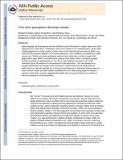Thin-slice perception develops slowly
Author(s)
Balas, Benjamin; Kanwisher, Nancy; Saxe, Rebecca R.
DownloadKanwisher_Thin-slice perception.pdf (635.3Kb)
PUBLISHER_CC
Publisher with Creative Commons License
Creative Commons Attribution
Terms of use
Metadata
Show full item recordAbstract
Body language and facial gesture provide sufficient visual information to support high-level social inferences from “thin slices” of behavior. Given short movies of nonverbal behavior, adults make reliable judgments in a large number of tasks. Here we find that the high precision of adults’ nonverbal social perception depends on the slow development, over childhood, of sensitivity to subtle visual cues. Children and adult participants watched short silent clips in which a target child played with Lego blocks either in the (off-screen) presence of an adult or alone. Participants judged whether the target was playing alone or not; that is, they detected the presence of a social interaction (from the behavior of one participant in that interaction). This task allowed us to compare performance across ages with the true answer. Children did not reach adult levels of performance on this task until 9 or 10 years of age, and we observed an interaction between age and video reversal. Adults and older children benefitted from the videos being played in temporal sequence, rather than reversed, suggesting that adults (but not young children) are sensitive to natural movement in social interactions.
Date issued
2012-03Department
Massachusetts Institute of Technology. Department of Brain and Cognitive SciencesJournal
Journal of Experimental Child Psychology
Publisher
Elsevier
Citation
Balas, Benjamin, Nancy Kanwisher, and Rebecca Saxe. “Thin-Slice Perception Develops Slowly.” Journal of Experimental Child Psychology 112, no. 2 (June 2012): 257–264.
Version: Author's final manuscript
ISSN
00220965